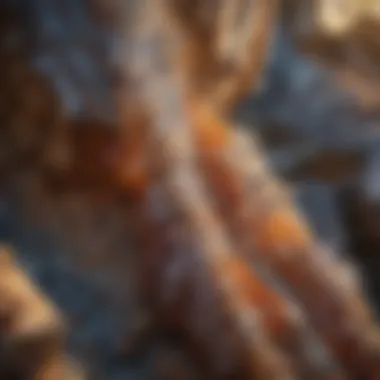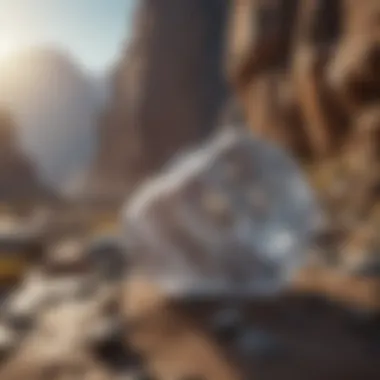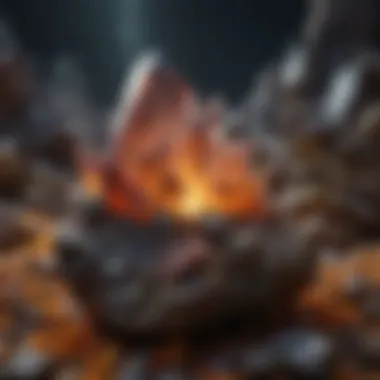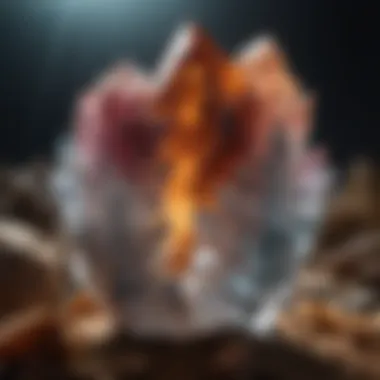Unveiling the Enigmatic Nature of Crystal-Laden Rocks: An Exhaustive Exploration


Rock and Fossil Identification
Rocks that contain crystals are a fascinating subject for rock and fossil collectors, as they offer a peek into the intricate world of geology and mineral formations. Identifying these crystal-bearing rocks requires a keen eye for detail and an understanding of the specific characteristics to look for. Through careful observation, collectors can differentiate between various types of rocks and fossils based on their crystal formations, textures, and color patterns. Utilizing tools such as magnifying glasses, geology hammers, and UV lights can aid in the identification process, allowing rock enthusiasts to uncover the hidden treasures within each specimen.
Geological Insights
Delving deeper into the geological insights surrounding crystals in rocks unveils a wealth of knowledge about the Earth's ancient history and mineral composition. By studying the geological formations and processes that lead to the creation of crystal-bearing rocks, collectors can gain a deeper appreciation for the complex interplay of pressure, temperature, and time that shape these natural wonders. Exploring the historical significance of rocks and fossils embedded with crystals provides a window into past eras and ecosystems, offering valuable insights into the evolution of our planet. Additionally, uncovering notable discoveries in the field of crystal-infused rocks sheds light on groundbreaking research and developments within the scientific community, enriching the understanding of these geological marvels.
Introduction to Crystal-Bearing Rocks
In this section, we explore the essential foundation of crystal-bearing rocks, setting the stage for a profound journey into the depths of Earth's mineral wonders. Understanding the intricate relationship between crystals and rocks unveils a world of scientific marvels and aesthetic beauty. This exploration lays the groundwork for delving deeper into the formation, significance, and identification of crystal-bearing rocks.
Understanding Crystal Formation
The Process of Crystal Growth
Delving into the process of crystal growth unveils a mesmerizing natural phenomenon. Crystals form through a meticulous dance of atoms aligning and arranging themselves in geometric patterns over time. This crystallization process reflects the Earth's geological history and the conditions under which rocks solidified. Understanding the nuances of crystal growth provides valuable insights into the composition and history of crystal-bearing rocks within geological formations.
Factors Influencing Crystal Size and Shape
The size and shape of crystals are influenced by a myriad of factors, including temperature, pressure, and mineral composition. These elements play a crucial role in determining the final form of crystals found in rocks. By exploring these influences, we gain a deeper appreciation for the diverse morphology of crystals and the intriguing variations that exist in crystal-bearing rocks. Understanding the multifaceted factors that shape crystals enhances our ability to interpret geological processes and the formation of mineral specimens.
Significance of Crystals in Rocks
The Role of Crystals in Geology
Crystals serve as essential indicators of the geological history embedded within rocks. By studying crystals, geologists can decipher the conditions under which rocks formed, providing valuable insights into Earth's evolution. The presence of specific crystals can help identify mineral resources, understand tectonic processes, and unravel the changes that have shaped our planet over eons. Their role in geology extends beyond mere aesthetics, offering a window into the Earth's past and future.
Importance of Crystal-Bearing Rocks to Collectors
For enthusiasts and collectors alike, crystal-bearing rocks hold immense value beyond their geological significance. The allure of crystals lies in their unique aesthetic appeal, metaphysical properties, and cultural significance. Collectors are drawn to the beauty and rarity of crystal specimens, expanding their collections as a reflection of their passion for Earth's treasures. Understanding the importance of crystal-bearing rocks to collectors sheds light on the multifaceted relationships humans have with these natural marvels, bridging art, science, and spirituality.
Types of Crystal-Bearing Rocks
In this section of the comprehensive guide about unveiling the mysteries of crystals in rocks, we delve into the essential topic of Types of Crystal-Bearing Rocks. Understanding the different types of rocks that house these captivating crystals is crucial in recognizing the diverse geological formations found in nature. By exploring the distinctive characteristics and properties of crystal-bearing rocks, enthusiasts and collectors can gain a deeper appreciation for the beauty and complexity of these formations.
Igneous Rocks


Formation of Crystals in Igneous Rocks
The formation of crystals in igneous rocks is a fascinating process that offers insights into the cooling and solidification of molten rock. As magma cools, crystals begin to form within the rock matrix, influenced by factors such as cooling rate, mineral composition, and pressure conditions. The specific aspect of crystal growth in igneous rocks contributes significantly to our understanding of mineral formation and geological processes. By studying the formation of crystals in igneous rocks, researchers and collectors can unravel the intricate details of how these unique structures come to exist.
Common Crystal Types Found in Igneous Rocks
Igneous rocks encompass a wide variety of crystal types, ranging from commonly found minerals like quartz and feldspar to more rare specimens such as beryl and tourmaline. These crystal formations provide valuable insights into the composition and history of the rock, offering clues about the conditions under which the rock was formed. By identifying and studying the common crystal types found in igneous rocks, geologists and collectors can piece together the puzzle of Earth's geological past, one crystal at a time.
Sedimentary Rocks
Crystals in Sedimentary Rock Formations
The presence of crystals in sedimentary rock formations adds a layer of complexity and intrigue to these geological structures. Crystals within sedimentary rocks can serve as indicators of past environmental conditions, mineral sources, and deposition processes. By examining the crystals found in sedimentary rocks, researchers can uncover clues about the history of the Earth's surface and the forces that have shaped it over time. Understanding the significance of crystals in sedimentary rock formations enriches our knowledge of Earth's dynamic geological processes.
Distinctive Features of Crystal-Bearing Sedimentary Rocks
Crystal-bearing sedimentary rocks exhibit unique features that set them apart from other rock types. From the intricate patterns formed by crystal growth to the color variations and crystal alignments within the rock matrix, these distinctive characteristics offer a glimpse into the diverse world of sedimentary formations. Exploring the features of crystal-bearing sedimentary rocks allows collectors and enthusiasts to appreciate the beauty and complexity of these natural wonders, showcasing the artistry of Mother Nature in creating intricate crystal structures.
Metamorphic Rocks
Transformation of Rocks into Crystals
The transformation of rocks into crystals through the process of metamorphism is a remarkable phenomenon that highlights the dynamic nature of Earth's geological processes. As existing rocks undergo intense heat and pressure conditions, their mineral composition changes, leading to the formation of new crystal structures. This transformational process results in the creation of unique and visually stunning crystal formations within metamorphic rocks. Studying the transformation of rocks into crystals offers valuable insights into the geological forces at play and the rich diversity of Earth's mineral treasures.
Notable Crystal Formations in Metamorphic Rocks
Metamorphic rocks harbor a wealth of notable crystal formations that showcase the beauty and complexity of mineral recrystallization. From the vibrant hues of garnet to the intricate patterns of staurolite, these crystal formations tell a story of geological transformation and renewal. By exploring the notable crystal formations found in metamorphic rocks, collectors and geologists can marvel at the sheer variety and craftsmanship of these natural creations, each a testament to the Earth's ever-evolving landscape.
Fascinating Crystal Varieties
In this comprehensive guide, the section on "Fascinating Crystal Varieties" delves into the diverse and intriguing world of crystals found within rocks. The exploration of crystal varieties is crucial in understanding the complex nature of crystal-bearing rocks and the unique formations they exhibit. By focusing on specific crystal varieties, readers can gain insights into the distinctive characteristics, benefits, and considerations associated with these intricate geological wonders.
Quartz Crystals
Properties and Characteristics of Quartz
Delving into the properties and characteristics of quartz provides a profound understanding of this ubiquitous crystal within the realm of crystal-bearing rocks. Quartz is renowned for its remarkable clarity, hardness, and wide range of colors, making it a highly desirable choice for collectors and enthusiasts. Its key characteristic lies in its piezoelectric properties, where it can generate electricity under pressure, showcasing its versatility and practical applications in various fields. The unique feature of quartz lies in its ability to retain its luster and clarity over time, ensuring its enduring allure in both scientific and aesthetic pursuits.


Locations Known for Quartz Crystal Deposits
Exploring the locations known for quartz crystal deposits unravels the geological significance of specific regions in the world. Regions such as the Ouachita Mountains in Arkansas, the Alps in Europe, and Brazil's Minas Gerais are renowned for their abundant quartz crystal deposits, attracting gemologists and rock enthusiasts alike. The key characteristic of these locations is the geological formations and mineral compositions that facilitate the formation of high-quality quartz crystals, making them sought-after destinations for crystal collectors. The unique feature of these locations is the diverse array of quartz varieties found, ranging from smoky quartz to amethyst, each bearing its distinctive beauty and allure.
Amethyst Geodes
Formation Process of Amethyst Geodes
The formation process of amethyst geodes unveils the intricate journey of how these stunning geological formations come into existence. Typically formed within hollow agate nodules, amethyst geodes develop as silica-rich fluids seep into cavities and slowly crystallize over millions of years. The key characteristic of amethyst geodes lies in their stunning purple hues, caused by iron impurities during the crystallization process, making them a popular choice among collectors and jewelry designers. The unique feature of amethyst geodes is their hollow interior filled with sparkling amethyst crystals, creating captivating natural art pieces revered for their beauty.
Notable Amethyst Geode Discoveries
Exploring notable amethyst geode discoveries uncovers a rich history of extraordinary findings that have captivated the world. Discoveries such as the "Empress of Uruguay" in Artigas, Uruguay, and the "Thunder Bay Amethyst Mine" in Canada showcase the exceptional size and quality of amethyst geodes unearthed in diverse locations globally. The key characteristic of these discoveries is the immense value and beauty encapsulated within these geological marvels, drawing attention from both collectors and the general public. The unique feature of these discoveries is the intricate patterns and formations exhibited by the amethyst crystals, each telling a story of the earth's mysterious and fascinating processes.
Calcite Crystals
Unique Qualities of Calcite Crystals
Exploring the unique qualities of calcite crystals sheds light on the distinct properties that set them apart from other crystal varieties. Calcite is recognized for its remarkable double refraction property, where objects viewed through calcite appear double due to light splitting upon entering the crystal. This unique characteristic makes calcite crystals a popular choice for scientific experiments and optical applications, offering a fascinating insight into the behavior of light within crystals. The key characteristic of calcite crystals lies in their diverse range of colors and formations, showcasing the diverse beauty and versatility of this mineral in geological exploration and research.
Varieties of Calcite Crystal Formations
Diving into the varieties of calcite crystal formations unravels a spectrum of stunning geometries and colorations exhibited by this versatile mineral. From rhombohedral to scalenohedral forms, calcite crystals showcase a diverse array of shapes and structures, each depicting the unique crystallization processes that occurred within geological formations. The key characteristic of calcite crystal formations is their intricate patterns and growth habits, reflecting the environmental conditions that influenced their development. The unique feature of calcite crystal formations is the vibrant colors they display, ranging from icy whites to vivid oranges, adding a visual allure to geological collections and scientific studies.
Pyrite Crystals
Characteristics of Pyrite Crystals
Delving into the characteristics of pyrite crystals unveils the fascinating properties and allure of this distinctive mineral. Pyrite is renowned for its brassy yellow hue and metallic luster, mimicking gold and earning it the nickname "fool's gold." The key characteristic of pyrite crystals lies in their cubic crystal system, forming intricate geometric shapes that captivate collectors and mineral enthusiasts. The unique feature of pyrite crystals is their association with sulfide ore deposits, showcasing their geological significance in identifying potential mineral resources and understanding earth's mineralogical processes.
Occurrences of Pyrite in Different Rock Types
Exploring the occurrences of pyrite in different rock types elucidates the diverse geological settings where this mineral can be found. Pyrite is commonly associated with sedimentary rocks like shale, where it forms nodules and concretions, showcasing its affinity for certain depositional environments. The key characteristic of pyrite occurrences in different rock types is their role as indicators of past environmental conditions, providing valuable insights into ancient ecosystems and geological history. The unique feature of pyrite occurrences is their significance in industrial processes, as pyrite is a vital source of sulfur and a precursor for sulfuric acid production, highlighting its economic importance in various sectors.
Identifying and Collecting Crystal-Bearing Rocks
Identifying and Collecting Crystal-Bearing Rocks is a crucial aspect of this comprehensive guide on Unveiling the Mysteries of Crystals in Rocks. Rock and fossil collectors, who form the target audience of this article, will find this section particularly enlightening. By understanding the significance of identifying and collecting these unique geological specimens, enthusiasts can deepen their appreciation for the Earth's mineral treasures and the intricate formations they hold.


Key Identifiers of Crystal-Bearing Rocks
Physical characteristics to look for:
In the realm of crystal-bearing rocks, specific physical characteristics serve as key identifiers for collectors. These traits may include crystal size, color, transparency, and any distinctive formations within the rock matrix. By honing in on these discerning features, collectors can not only identify the type of crystal present but also gain insights into the geological processes that gave rise to these formations. The ability to recognize these physical attributes proves invaluable for enthusiasts looking to expand their collection with unique and diverse specimens, making it a popular choice for this article. The unique feature of these physical characteristics lies in their role as windows to Earth's history, providing a glimpse into the conditions that shaped these mesmerizing crystalline structures. While these characteristics offer a wealth of information, collectors must also be cautious of misinterpretations that may arise from the variability in natural formations.
Tools for crystal identification:
Equipping oneself with the right tools is essential for accurate crystal identification. Tools such as magnifying lenses, UV lights, hardness picks, and specific mineral testing kits play a crucial role in this process. These tools aid collectors in examining crystal features at a microscopic level, discerning mineral properties, and conducting tests to determine crystal composition. By utilizing these tools effectively, collectors can confidently identify crystals, differentiate between similar-looking specimens, and enhance their overall collection with authenticated pieces. The advantageous nature of these tools in crystal identification underscores their importance in this article, elevating the level of detail and precision in rock and fossil collections. The unique feature lies in the ability of these tools to unveil hidden characteristics of crystals, guiding collectors towards a deeper understanding of geological formations and mineral compositions. While these tools offer numerous benefits, collectors must also be mindful of potential limitations and the need for continual learning to refine their identification skills.
Ethical Collection Practices
Responsible ways to collect crystal-bearing rocks:
Ethical considerations in crystal collection are paramount to preserving natural ecosystems and geological formations. Responsible collectors prioritize sustainable extraction practices, seeking permission from landowners, following designated collection guidelines, and avoiding disruptive activities that may harm fragile habitats. The key characteristic of responsible collecting is the emphasis on conservation and respect for the environment, making it a highly regarded practice within the rock and fossil collecting community. The unique feature of responsible collection methods lies in their potential to contribute positively to geological conservation efforts, ensuring that future generations can also appreciate the beauty and scientific value of crystal-bearing rocks. While there are clear advantages to ethical collection practices, collectors must remain vigilant against illegal or destructive actions that can degrade natural landscapes and diminish the availability of these geological treasures.
Preservation methods for rock specimens:
Preserving rock specimens is essential for maintaining their integrity and scientific value over time. Various preservation methods, such as storing specimens in protective display cases, controlling humidity levels, and implementing measures to prevent chemical degradation, are vital for long-term conservation. By employing these preservation techniques, collectors can safeguard the aesthetics and structural stability of their specimens, ensuring they remain pristine for future observation and study. The beneficial nature of preservation methods highlights their significance in this article, providing collectors with the knowledge and tools needed to prolong the lifespan of their cherished rock and crystal collections. The unique feature of preservation practices lies in their role as guardians of geological heritage, enabling collectors to pass on valuable specimens to future generations while maintaining their educational and scientific value. Despite the advantages of preservation methods, collectors must stay informed about best practices and adapt to evolving conservation standards to uphold the authenticity and beauty of their collections.
Preserving and Displaying Crystal Finds
Preserving and displaying crystal finds is a crucial aspect discussed in this comprehensive guide on unveiling the mysteries of crystals in rocks, catering specifically to rock and fossil collectors as the target audience. It plays a vital role in maintaining the integrity and longevity of crystal-bearing specimens while also showcasing their beauty and uniqueness to enthusiasts and researchers. Proper preservation and display not only protect the specimens but also contribute to the appreciation and understanding of these geological wonders.
Proper Storage Techniques
Moisture control for crystal preservation
In this article, moisture control for crystal preservation is a key focal point in ensuring the durability and appearance of crystal specimens. Maintaining optimal moisture levels is essential to prevent deterioration, discoloration, or structural damage to the crystals over time. The controlled environment helps preserve the natural aesthetic and properties of the crystals, facilitating long-term storage and display without compromising their integrity.
Avoiding damage during storage
The emphasis on avoiding damage during storage underscores the significance of proper handling and placement of crystal specimens. By minimizing the risk of physical harm, such as scratches, breakage, or exposure to harmful elements, the longevity and visual appeal of the crystals are safeguarded. Implementing suitable storage solutions and protective measures reduce the potential for accidental damage and allow for safekeeping of the specimens for generations to come.
Displaying Crystals in Rock Collections
In the realm of rock and fossil collections, creative display ideas for crystal specimens serve as a captivating way to exhibit the beauty and diversity of crystal formations. These innovative presentation methods not only enhance the aesthetic appeal of collections but also offer educational value and inspiration to viewers. By showcasing crystals in a visually engaging manner, collectors can share their passion for geology and spark curiosity among audiences.
Creative display ideas for crystal specimens
Exploring creative display ideas for crystal specimens opens up opportunities to highlight the distinct characteristics and intricate details of each specimen effectively. From innovative mounting techniques to thematic arrangements, these display concepts elevate the visual impact of crystal collections, attracting interest from both experienced collectors and newcomers alike. The fusion of artistry with scientific appreciation enhances the overall viewing experience and cultivates a deeper connection with the mesmerizing world of crystal-bearing rocks.
Tips for showcasing crystal-bearing rocks
Providing tips for showcasing crystal-bearing rocks encapsulates practical advice on presenting specimens in their best light. Whether focusing on lighting, positioning, or background setting, these tips offer insights into optimizing the display to accentuate the individual beauty and geological significance of each crystal specimen. By following these suggestions, collectors can curate compelling exhibitions that not only educate but also inspire a sense of wonder and admiration for the natural mineralogical treasures they behold.







